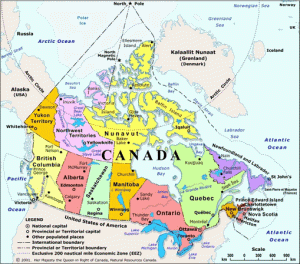
It would be nice to think a visit to Alberta and the oilsands by New Brunswick’s premier would be all that is needed to significantly move the yardsticks on alleviating the impact of burgeoning oil supply in the absence of adequate transportation options.
It’s heartening to see a premier from a province other than Alberta or Saskatchewan personify what it means to be part of Confederation.
By coming to Alberta and visiting the oilsands, Premier David Alward sent the rest of Canada two very important messages.
One is that Alberta’s issue of too much bitumen and not enough export access is not just an Alberta problem – it’s a national one.
The second message implicit in his visit was, that as part of a Confederation, there are times when it’s important to work together to solve problems.
It all helps – but it’s not enough.
According to a study published by the TD Bank, energy sector investment accounted for 20 per cent of Canada’s economic growth in 2010 and 2011.
A 2012 report by the Canadian Energy Research Institute estimated if the pipelines currently planned are not built, Canada will forego $1.3 trillion in terms of economic growth and $276 billion in taxes between 2011 and 2035.
That’s not small change. As things stand right now, the differential is costing the sector, and the country, $75 million a day in lost revenue.
What does this mean? While Imperial Oil might have kicked off the ‘uh oh, costs are rising’ refrain last week when it revealed its Kearl Lake project will cost $2 billion more than expected, the announcement by Suncor late Tuesday hit a home run in the context of the longer term implications of being landlocked in bitumen.
Suncor’s $1.5 billion writ-edown on its Voyageur project shows the current economics don’t support the development of the resource.
This is all about rising costs and wide differentials that decrease the returns per barrel.
Ultimately this leads to a decline in investment.
It’s not a happy picture.
What could change it?
Sending oil eastward via TransCanada’s infrastructure and on to New Brunswick would help, however, the reality is this can’t happen overnight.
The pipe ends at Quebec, which means a new pipe would have to constructed from Quebec to New Brunswick. The time frame for this would extend into 2018 or 2019; not soon enough to narrow that gap, which has been as great as $42.50 per barrel in December.
As a reality check, oil traded at a level as big as that differential back in 2004, when West Texas Intermediate averaged $41.43 US per barrel.
Of course, if TransCanada’s Keystone XL Pipeline were to be approved by U.S. President Barack Obama – and he is the one ultimately responsible for giving it the green light – the issue of the differential would be addressed.
What Obama must wrestle with is that the approval of Keystone will stand as an acknowledgment that the United States is going to need oil as part of its ongoing energy mix.
The question, perhaps, that Canadians – and more specifically, Prime Minister Stephen Harper – should be asking is whether there is anything Canada should do to get Keystone approved?
One issue that has been raised, on which there is concern, is that of environmental impact.
Last week the journal Nature pointed out emissions generated by oilsands production is not something that should be taken into consideration in the Keystone approval process as they don’t occur in the United States.
However, is it time for Canada to look at a way to internalize that so-called cost of carbon as a way to neutralize the environmental opposition to oilsands development?
The Canadian government has long said it would follow the lead of the U.S. when it came to setting carbon policy.
But it might just be time, for the sake of the Canadian economy, to look at things from a different perspective and take the lead on an issue that the U.S. itself has successfully avoided. When examined from this perspective, it boils down to an issue of leadership at the federal level.
What is Prime Minister Harper prepared to do to ensure the long term economic prosperity of this country?
“Governments could also champion the economic opportunities that increased production and diversification of markets could provide,” said the TD Bank in its study.
Where is that ‘government championing?’
So far, there has been some support from provincial leaders – thanks in large part to Premier Alison Redford’s efforts, but the silence from the prime minister’s office on this issue, thus far, has been deafening.
On Wednesday, the University of Calgary’s School of Public Policy released a study addressing the challenges faced by the lack of export capacity.
What’s needed, said Michal Moore, one of the study’s authors, is a mechanism through which a plan for alleviating the constraints to continued growth.
“We’re not being coordinated in our responses … there is no forum to uniformly discuss all those (options). The eastern pipeline is attractive, but I don’t have a standard by which to weigh it today, but I don’t think anyone does either. And what our premier is pointing out … is the need for some sort of a common forum to discuss an energy strategy where we all can see what the facts are at the same time. It’s (the eastern pipeline) attractive, certainly stimulates public interest.
“I don’t have any numbers by which to vet it but it highlights the issue that we don’t have a common strategic forum by which to discuss it,” said Moore.
And so, the puck goes to you, Prime Minister Harper. The time has come for you to take a shot, and lead.
Last week the journal Nature pointed out emissions generated by oilsands production is not something that should be taken into consideration in the Keystone approval process as they don’t occur in the United States.
However, is it time for Canada to look at a way to internalize that so-called cost of carbon as a way to neutralize the environmental opposition to oilsands development?
The Canadian government has long said it would follow the lead of the U.S. when it came to setting carbon policy.
But it might just be time, for the sake of the Canadian economy, to look at things from a different perspective and take the lead on an issue that the U.S. itself has successfully avoided. When examined from this perspective, it boils down to an issue of leadership at the federal level.
What is Prime Minister Harper prepared to do to ensure the long term economic prosperity of this country?
“Governments could also champion the economic opportunities that increased production and diversification of markets could provide,” said the TD Bank in its study.
Where is that ‘government championing?’
So far, there has been some support from provincial leaders – thanks in large part to Premier Alison Redford’s efforts, but the silence from the prime minister’s office on this issue, thus far, has been deafening.
On Wednesday, the University of Calgary’s School of Public Policy released a study addressing the challenges faced by the lack of export capacity.
What’s needed, said Michal Moore, one of the study’s authors, is a mechanism through which a plan for alleviating the constraints to continued growth.
“We’re not being coordinated in our responses … there is no forum to uniformly discuss all those (options). The eastern pipeline is attractive, but I don’t have a standard by which to weigh it today, but I don’t think anyone does either. And what our premier is pointing out … is the need for some sort of a common forum to discuss an energy strategy where we all can see what the facts are at the same time. It’s (the eastern pipeline) attractive, certainly stimulates public interest.
“I don’t have any numbers by which to vet it but it highlights the issue that we don’t have a common strategic forum by which to discuss it,” said Moore.
And so, the puck goes to you, Prime Minister Harper. The time has come for you to take a shot, and lead.
By Deborah Yedlin, Calgary Herald February 7, 2013 7:54 AM





